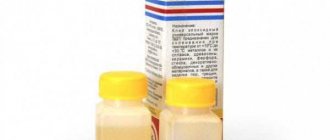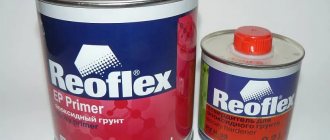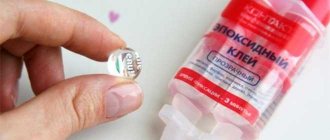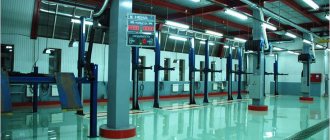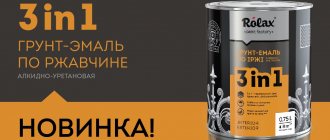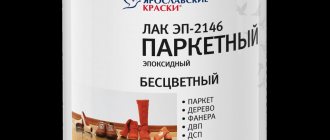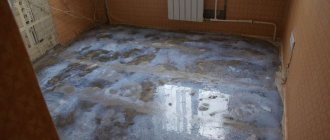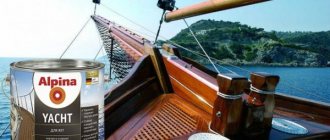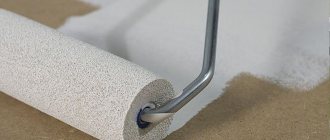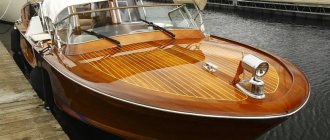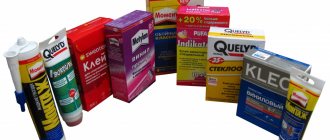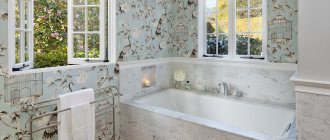Epoxy primers belong to the group of paints and varnishes that provide anti-corrosion coating to metal surfaces due to the presence in their composition of special resins and chemically active additives that do not allow the development of corrosive processes on the metal surface. Available in iron containers of various capacities, and also as an aerosol. The aerosol version of the primer is produced on the same basis as in iron containers.
Advantages
According to experts, the main positive quality of epoxy-based soil (regardless of its shape) is the ability to withstand significant temperature fluctuations, atmospheric and mechanical loads.
The second important property is the minimum drying time, which makes using the composition as convenient as possible. This trifecta of advantages is completed by adhesion; the applied composition firmly adheres to the metal.
The treated body retains all visual features and technological characteristics for a long time.
Practice shows that the epoxy composition is suitable even for metal surfaces that are in constant contact with water, so it can provide the highest level of corrosion resistance to a car that is in contact with moisture only periodically.
Classification Features
The number of compositions presented on the modern market amounts to dozens; they can be classified according to a variety of technological and operational indicators, be it the degree of adhesion or the effect on the metal. However, this division is not the most significant.
The most important factor is the composition, which allows the products to be divided into two large groups:
Primers in aerosol form
This group of products should be considered separately. The price of primer in a can is higher compared to its analogues in ordinary metal containers, however, it has an undeniable advantage - ease of use.
There is no need for dilution or additional purchase of solvents, pigments and other additives. The aerosol is immediately ready for use; you just need to shake the can vigorously before spraying, or perform other simple steps indicated by the manufacturer.
If it is planned to process the entire vehicle body, the use of an aerosol is not economically feasible; the financial investment will be too significant.
Another thing is the repair of individual sections of the body, be it metal sills or fenders. In such a situation, a spray can is the optimal solution, thanks to which you will be able to save a lot of time and money, carry out restoration on your own, without purchasing auxiliary materials or contacting specialists.
Useful video on why epoxy primer is in cylinders:
Famous brands
As already noted, there are many primers available in stores. Without experience, it is extremely difficult to find a solution that will be truly durable and reliable, capable of protecting the car body from external negative factors.
However, based on reviews from drivers and service center specialists, some conclusions can be drawn.
Novol soil (Protect 360), produced by the Polish brand of the same name, has a good reputation. Yes, this product is more expensive than many of its analogues, but the high cost is fully compensated by the quality.
Practice shows that the composition is suitable for treating metal surfaces, even those in poor condition, covered with significant areas of intense corrosion.
For example, it is soil from Poland that is used by many commercial enterprises specializing in passenger or cargo transportation.
The solution promotes maximum protection of metal from rust and temperature fluctuations, extending the life of vehicles. Increases the overall profitability of the enterprise by reducing costs associated with repairs and machine downtime.
Video, technical information for Novol epoxy primer:
Among the budget solutions, we can highlight the Russian Reoflex , the instructions for use of which are quite standard. Experts note the optimal consistency of the composition, which simplifies work, as well as decent corrosion protection characteristics, quite comparable with more expensive brands.
The only drawback is less durability compared to expensive compounds.
Video on the topic, educational film from the Reoflex trademark on repair and painting of metal parts (hood):
Use Cases
The use of epoxy resin primers is a complex issue that requires careful consideration. To begin with, let’s look at the situations in which the composition is relevant:
a decorative meaning in processing fiberglass elements with its help . The composition (in combination with an acrylic filling primer) eliminates the possibility of the fine mesh characteristic of such parts showing through, which often forms after the painting procedure.
Positive traits
Buyers note the following:
- the formation of a dense and hard layer on the treated surface, which is particularly resistant compared to polyester putties;
- anti-corrosion properties of the material;
- high adhesion rates in relation to any material, regardless of its type and structure.
Although such compositions are well suited for treating car surfaces during repairs and provide adequate protection, it is worth noting that for the surface on which epoxy primer is applied to completely dry, you will have to wait some time, which is not always convenient.
Application
A universal two-component anti-corrosion epoxy primer is used as an anti-corrosion coating for ferrous metals, galvanized surfaces, light alloys, and for car repairs. After applying the primer (including an aerosol, which is produced on the same basis), such surfaces can be coated with any type of enamels - glyphthalic, polyurethane and other compatible paints and varnishes.
Two-component epoxy primer should not be used with paints and varnishes that are incompatible with it, such as alkyd-acrylic, alkyd-urethane, polyvinyl chloride or any other similar coatings.
Primers are excellent for application to any surface with low processing quality: for example, after working with a metal surface with machines or pneumatic tools. All soils in this group are characterized by high resistance to moisture and good plasticity of the material.
In addition, a two-component anti-corrosion primer based on epoxy resin can be tinted with pigment pastes or decorative fillers, for example, for better color rendition under the main coating on a car. The big advantage of epoxy primers is their high hygroscopicity: they do not transmit or absorb water, and also have strength and resistance to mechanical chips, which is important when painting a car. If we compare acidic and epoxy primers based on these characteristics, then, without belittling the other advantages of acidic primer, it does not have the same hygroscopicity as a two-component epoxy resin-based material and allows water to pass through. But where automotive epoxy material loses is in drying time; due to its chemical composition, acid primer dries much faster.
The primer is applied using a roller or, in larger quantities, with a spray gun. For minor car repairs, you can use a store-bought spray in a can. The composition of car aerosol is no different from epoxy coating in cans; it is prepared on the same basis, it does not need to be diluted and is ready for use.
What characterizes the composition
One of the important advantages of soils is their high resistance to temperature and mechanical influences, good adhesion properties and uniform drying of layers.
Buyers note that car surfaces coated with such a composition will be well protected, even before the main coat of paint is applied. In addition, the composition does not fade or peel off from the surface.
As customers note in reviews of the Reoflex epoxy primer, the composition can indeed (as the manufacturer claims) be used to coat metal surfaces that are under water or subject to frequent exposure to it, without losing the performance properties of the material.
Due to its characteristics, multi-component automotive primer can be called an effective protective composition among the main high-strength paintwork materials. To produce such products, epoxy resin is used, which is the main component.
It is interesting that matte compositions, including Reoflex epoxy primer, contain not only resins, but also chemical components.
ONB Thinner Cerberus, 1l
Product code: 4005
| vendor code | 4005 |
| Manufacturer country | European Union |
Cashback for purchase + 8 R
Product availability: 323
Buy in 1 click
You can also buy goods from us on credit or in installments? We cooperate with banks that provide the opportunity to buy goods in a store on credit or in installments. More details
Availability in stores
| st. M.Eremenko, 4a | 6 in stock |
| Krasninskoe highway, 17 | 12 in stock |
| Tikhvinka village, 69 Market "City of Masters" | 9 in stock |
| st. Shevchenko, 75 | 296 in stock |
Receipt and delivery
| Pickup from the Autospectr store is free |
| Free delivery by courier in Smolensk free of charge |
| Delivery throughout Russia TK from 350 rub. |
- Description
- Characteristics
- Similar products
- Reviews
Common Questions
Now we will give answers to questions popular among motorists who decide to treat the body of their car with epoxy primer:
1. Is it possible to apply epoxy primer over acidic primer ? Not worth it.
The most reputable manufacturers of epoxy compounds have conducted research showing that acid residues can interfere with the normal development of resin strength. This increases the drying time, does not allow the primer to firmly “adhere” to the base, and manifests itself in peeling and the formation of cracks.
See the test, applying epoxy primer to acidic:
2. Epoxy primer or acid primer: which is better ? The basis of the acid primer is an acid that provides chemical cleaning of the metal, conducts etching, which promotes better adhesion of subsequent coatings.
Epoxy compounds are more technologically advanced and versatile. Yes, they take longer to dry, but they provide excellent protection against rust and improve the durability of the decorative trim of the body. He is better.
Watch a useful video on which insulating primer to choose, epoxy or acid:
3. How to dilute it ? It is better to use branded thinners and hardeners in the proportions recommended by the manufacturer. If you don’t have a proprietary thinner at hand, and the viscosity of the composition needs to be reduced, you can use universal thinners, for example, Solvent, available in all hardware stores.
If we talk about whether it is possible to apply putty on epoxy primer and whether it is possible to paint on epoxy primer , then in both cases the answer is yes.
The main thing is to observe the drying time, which was indicated in the previous paragraph. By the way, recently primers have begun to be found that immediately contain coloring pigments. They eliminate the need to paint the surface, while maintaining all the characteristics of the soil.
Such compositions are sold in aerosol form and are ideal for treating small areas of the body, as they save a lot of time.
Source
Before as…
Before you start priming, do not forget to cover the “non-working” parts of the body with masking tape and film (or paper). Unless, of course, you want to spend a long time and painfully scrubbing the glass, handles or moldings off the ground.
If you are priming partially, when masking, do not paste it too close to the repair area in order to avoid applying the primer “end-to-end” - otherwise a step will form, which may eventually be visible even on the paint. You can read more about camouflage here.
When you degrease the surface before priming, remember that the putty cannot be heavily wetted with a degreaser, as it absorbs and retains moisture for a long time. Therefore, it is enough to lightly walk over it with a dampened napkin.
Review of popular primer manufacturers
The paint and varnish market offers a wide selection of primers in aerosol form for treating various surfaces, produced by Russian companies and leading companies in foreign countries. Krasko LLC is a well-known company that produces anti-corrosion paint and varnish coatings for the protection of metal structures. The Finnish company Turu valo produces environmentally friendly paints and varnishes, among them there are products that combine the functions of three components: a rust converter, an anti-corrosion primer and decorative enamel. The Kudo automobile series also includes products in aerosol form, which are known to many Russian car enthusiasts and are in demand. The BOSNY company from Greece is familiar in many countries around the world. Produces aerosols and sprays for various surfaces. SOLID - the company supplies high-quality products for all types of professional repairs. With SOLID acrylic primer you can level the surface of your car. The Tikkurila brand catalog contains paint and varnish products, which are impossible to do without when repairing metal surfaces. The world-famous HB-BODY corporation produces many of the main areas of automotive anti-corrosion chemicals: anti-corrosion agents, automotive paints, which are necessary for processing various car parts. Products of the HB-brand BODY occupies a leading position in the production of auto chemicals. Aerosols from this company are highly reliable, easy to use and have excellent performance characteristics. Before purchasing primers, you must carefully study the technical characteristics of the material and its application features. It is not worth saving on the primer mixture; you should choose products from a manufacturer that has proven itself well and is in high demand among consumers. REOFLEX epoxy primer contains resins and additives that prevent the formation of rust, ensures good adhesion of paints and varnishes to exposed metal and its protection from moisture. REOFLEX epoxy primer is intended for the repair of both cars and trucks and trailers. Also, an epoxy primer is necessary when restoring the paintwork of watercraft and metal products exposed to direct contact with the aquatic environment. REOFLEX epoxy primer has good adhesion to various surfaces (metals, wood, plastic, glass, concrete, etc.) and also has excellent insulating properties. Epoxy primer can also act as an insulating layer for incompatible paints and varnishes, preventing the dissolution of some materials by others. REOFLEX epoxy primer is combined in a 4:1 ratio with the hardener. Solvent P650 can be added to the resulting mixture up to 25%. Different documents indicate different lifetimes of the primer after combining with the hardener. We recommend using the mixture immediately after preparing it. Fill the spray gun with soil only through a filter funnel. We recommend a simple, inexpensive and reliable spray gun for applying primary primers. Application of epoxy primer is simple. Degrease the surface with a silicone cleaner, remove the gloss from the surface with red Scotchbrite manually or with P240 wheels using a sander. The surface after treatment must be clean from oils, dirt, flaking old paintwork, and corrosion. Degrease again. Apply epoxy primer with a spray gun in 2 medium-thick layers. Interlayer exposure 10 - 15 minutes at a temperature of 20 degrees Celsius. Drying time for epoxy primer is 12 hours at 20 degrees Celsius, and 45 minutes at 60 degrees Celsius. We recommend using REOFLEX primer at an air temperature of at least 10 degrees Celsius. Putties and paints and varnishes can be applied to the epoxy primer only after it has completely dried. Before applying paints and putties, it is necessary to remove the gloss from the dried epoxy primer: with gray Scotchbrite or Superfine manually on a dry surface, or with a P400 wheel using a sander. You can also remove the gloss with wet P800 sandpaper. We recommend REOFLEX epoxy primer for professional use.
Scope of use
Painting with epoxy primer is in demand not only when working on a vehicle - this type of substance can be used to coat other large objects, but only metal ones.
Important! The primer for concrete work should not be confused with the one used for metal work. These are completely different products in composition, and the result of the work can be unpredictable, not in the positive sense of the word.
In general, “epoxy” can be used in the following cases:
- on top of “bare” metal - it can be either steel or aluminum;
- over a mixed surface - with putty;
- as a final insulating layer;
- as a means of improving surface resistance to mechanical damage;
- application to fiberglass parts, but only as the first layer.
In any case, before you start treating the surface, you need to carefully read the instructions and make sure that this particular type of primer is suitable for a particular type of surface.
Epoxy primer for metal SG 34
Surface for epoxy primer
Before processing, you should properly prepare the surface - this way epoxy primer for cars adheres much better. The work algorithm is approximately as follows:
- clean the body from old paintwork and rust using a sandblaster or grinder;
- if necessary, carry out mechanical straightening;
- degrease the surface;
- treat the surface with anti-corrosion agents;
- defects need to be puttied;
- After the putty has dried, sand the surface.
Important: when working with the substance, you must follow safety precautions. The primer must be used strictly according to the manufacturer's instructions. Drafts and dust should not be allowed to form in the room.
How to prime a car body
If you plan to work with small defects, a spray can is quite suitable. The primer in a metal can must first be mixed with a solvent and, if necessary, a hardener. The latter is necessary if a one-component type of product is used.
The substance must be thoroughly stirred until smooth. The hardener must be added in stages, depending on the number of layers applied.
Car body primer
The composition must be diluted strictly as written in the instructions. You need to apply the substance with a roller or brush; you can also use a spray gun. The primer is applied with a brush or roller, taking into account the following rules:
- the first layer is very thin;
- After 15 minutes you can apply the second layer, and after another 15 minutes the third layer. Without reference to a time interval - you can apply a new layer when the previous one becomes matte;
- you need to apply the substance smoothly, but without staying in one place for a long time;
- Avoid abrupt transitions and gaps.
Using a spray gun, apply the primer as follows:
- the first layer should be thin and even, so the distance from the surface to the sprayer should be 20–30 cm;
- In order for the substance to be evenly distributed over the surface, the movements must be cross.
With this technology of applying the substance, there may be smudges and other minor defects, which can be easily removed by sanding before painting.
The room where the car surface is being primed should be free of dust, drafts and dirt. It is better if the lighting is daylight spectrum, of moderate brightness.
Priming a car before painting
If you plan to prime not the entire car, but only individual parts, the “non-working” areas must be covered with film and masking tape. The windows and headlights must also be covered.
Important! Do not forget about personal protective equipment while working!
Forum vgaraje.su
Primary soils - brands and manufacturers
Khoma » May 31, 2013, 20:36
In order to expand the knowledge base, as well as to break up the sound summer sleep on the “garage forum”, I am opening a new topic “Primary Soils”. This topic somewhat overlaps with the one already available on the forum here viewtopic.php?f=12&t=10 However , for the purpose of systematization, ordering, and also greater improvement, it is necessary to consider the soils properly and separately.
First, some general information:
a) Primary primer, sometimes called “adhesive”, is the first material that is applied to the prepared (degreased and sanded) “bare” metal. b) Two primary primers are used in preparatory work: acidic (also known as “acidic”, also known as “etching”) and epoxy. Acid and epoxy primers solve the same problem - to prevent water from reaching the metal. However, the protection mechanism and technology for using these soils are different. That is. The etching primer reacts with the metal to form a waterproof phosphate film. Epoxy primer does not react with metal, but after polymerization it forms a dense film, also incapable of allowing water to pass through. That is, these soils are the same in their ability to prevent water from reaching the metal, although this is achieved in different ways. Etching and epoxy primers have different application technologies, and also differ slightly in the system of previous and subsequent coatings: 1. Acidic primer cannot be immediately covered with acrylic enamel - at least one layer of secondary primer is needed, and then you can paint (this rule has some exceptions , depending on the manufacturer) 2. Acid primer is most often applied in one wet layer (sometimes in two or even three, depending on the manufacturer) 3. Acid primer is not sanded (sometimes sanded, depending on the manufacturer) 4. Acid primer must Dry completely - this is necessary to complete the chemical reaction in the film of the material. Undried soil “locked” by subsequent coatings will not react completely and will not provide full protection.
